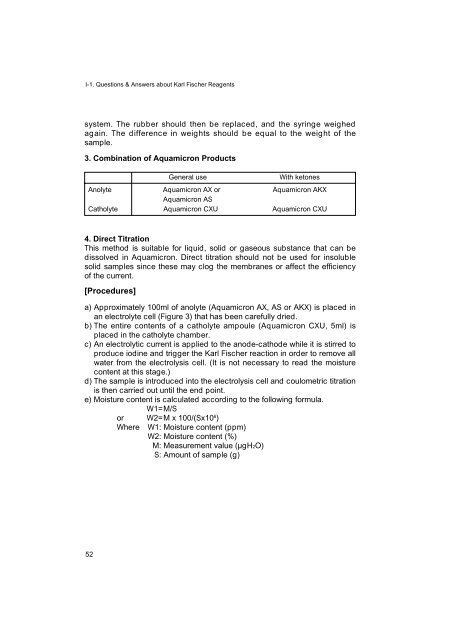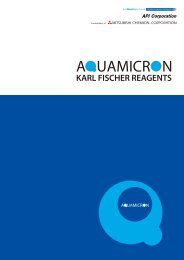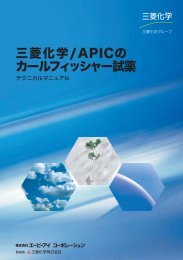Development of Karl Fischer Reagents
Development of Karl Fischer Reagents
Development of Karl Fischer Reagents
Create successful ePaper yourself
Turn your PDF publications into a flip-book with our unique Google optimized e-Paper software.
I-1. Questions & Answers about <strong>Karl</strong> <strong>Fischer</strong> <strong>Reagents</strong><br />
system. The rubber should then be replaced, and the syringe weighed<br />
again. The difference in weights should be equal to the weight <strong>of</strong> the<br />
sample.<br />
3. Combination <strong>of</strong> Aquamicron Products<br />
Anolyte<br />
Catholyte<br />
4. Direct Titration<br />
This method is suitable for liquid, solid or gaseous substance that can be<br />
dissolved in Aquamicron. Direct titration should not be used for insoluble<br />
solid samples since these may clog the membranes or affect the efficiency<br />
<strong>of</strong> the current.<br />
[Procedures]<br />
52<br />
General use With ketones<br />
Aquamicron AX or<br />
Aquamicron AS<br />
Aquamicron CXU<br />
Aquamicron AKX<br />
Aquamicron CXU<br />
a) Approximately 100ml <strong>of</strong> anolyte (Aquamicron AX, AS or AKX) is placed in<br />
an electrolyte cell (Figure 3) that has been carefully dried.<br />
b) The entire contents <strong>of</strong> a catholyte ampoule (Aquamicron CXU, 5ml) is<br />
placed in the catholyte chamber.<br />
c) An electrolytic current is applied to the anode-cathode while it is stirred to<br />
produce iodine and trigger the <strong>Karl</strong> <strong>Fischer</strong> reaction in order to remove all<br />
water from the electrolysis cell. (It is not necessary to read the moisture<br />
content at this stage.)<br />
d) The sample is introduced into the electrolysis cell and coulometric titration<br />
is then carried out until the end point.<br />
e) Moisture content is calculated according to the following formula.<br />
W1=M/S<br />
or W2=M x 100/(Sx10 6 )<br />
Where W1: Moisture content (ppm)<br />
W2: Moisture content (%)<br />
M: Measurement value (µgH2O)<br />
S: Amount <strong>of</strong> sample (g)




